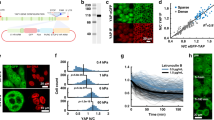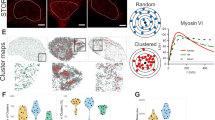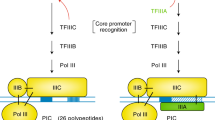Abstract
Several recent publications have demonstrated the importance of nuclear actin and nuclear myosin I in transcription. Here we review these publications and their implications. In addition, we discuss some important issues that should be addressed to gain a more comprehensive understanding of how these traditionally 'cytoplasmic' proteins are involved in transcription. We propose highly speculative models and mechanisms solely to stimulate thought and experimentation in this area.
This is a preview of subscription content, access via your institution
Access options
Subscribe to this journal
Receive 12 print issues and online access
$189.00 per year
only $15.75 per issue
Buy this article
- Purchase on Springer Link
- Instant access to full article PDF
Prices may be subject to local taxes which are calculated during checkout


Similar content being viewed by others
References
Lemon, B. & Tjian, R. Orchestrated response: a symphony of transcription factors for gene control. Genes Dev. 14, 2551–2569 (2000).
Cook, P.R. The organization of replication and transcription. Science 284, 1790–1795 (1999).
Sellers, J.R. Myosins: a diverse superfamily. Biochim. Biophys. Acta 1496, 3–22 (2000).
Hagen, S.J., Kiehart, D.P., Kaiser, D.A. & Pollard, T.D. Characterization of monoclonal antibodies to Acanthamoeba myosin-I that cross-react with both myosin-II and low molecular mass nuclear proteins. J. Cell Biol. 103, 2121–2128 (1986).
Rimm, D.L. & Pollard, T.D. Purification and characterization of an Acanthamoeba nuclear actin-binding protein. J. Cell Biol. 109, 585–591 (1989).
Berrios, M., Fisher, P.A. & Matz, E.C. Localization of a myosin heavy chain-like polypeptide to Drosophila nuclear pore complexes. Proc. Natl. Acad. Sci. USA 88, 219–223 (1991).
Green, D.M., Johnson, C.P., Hagan, H. & Corbett, A.H. The C-terminal domain of myosin-like protein 1 (Mlp1p) is a docking site for heterogeneous nuclear ribonucleoproteins that are required for mRNA export. Proc. Natl. Acad. Sci. USA 100, 1010–1015 (2003).
Clark, T.G. & Rosenbaum, J.L. An actin filament matrix in hand-isolated nuclei of X. laevis oocytes. Cell 18, 1101–1108 (1979).
Nakayasu, H. & Ueda, K. Association of actin with the nuclear matrix from bovine lymphocytes. Exp. Cell Res. 143, 55–62 (1983).
Lane, N.J. Intranuclear fibrillar bodies in actinomycin D-treated oocytes. J. Cell Biol. 40, 286–291 (1969).
Jockusch, B.M., Becker, M., Hindennach, I. & Jockusch, E. Slime mould actin: homology to vertebrate actin and presence in the nucleus. Exp. Cell Res. 89, 241–246 (1974).
Egly, J.M., Miyamoto, N.G., Moncollin, V. & Chambon, P. Is actin a transcription initiation factor for RNA polymerase B? EMBO J. 3, 2363–2371 (1984).
Rungger, D., Rungger-Brandle, E., Chaponnier, C. & Gabbiani, G. Intranuclear injection of anti-actin antibodies into Xenopus oocytes blocks chromosome condensation. Nature 282, 320–321 (1979).
Scheer, U., Hinssen, H., Franke, W.W. & Jockusch, B.M. Microinjection of actin-binding proteins and actin antibodies demonstrates involvement of nuclear actin in transcription of lampbrush chromosomes. Cell 39, 111–122 (1984).
Zhao, K. et al. Rapid and phosphoinositol-dependent binding of the SWI/SNF-like BAF complex to chromatin after T lymphocyte receptor signaling. Cell 95, 625–636 (1998).
Pestic-Dragovich, L. et al. A myosin I isoform in the nucleus. Science 290, 337–341 (2000).
Gillespie, P.G. et al. Myosin-I nomenclature. J. Cell Biol. 155, 703–704 (2001).
Nowak, G. et al. Evidence for the presence of myosin I in the nucleus. J. Biol. Chem. 272, 17176–17181 (1997).
Fomproix, N. & Percipalle, P. An actin-myosin complex on actively transcribing genes. Exp. Cell Res. 294, 140–148 (2004).
Philimonenko, V.V. et al. Nuclear actin and myosin I are required for RNA polymerase I transcription. Nat. Cell Biol. 6, 1165–1172 (2004).
Grummt, I. Life on a planet of its own: regulation of RNA polymerase I transcription in the nucleolus. Genes Dev. 17, 1691–1702 (2003).
Hofmann, W.A. et al. Actin is part of pre-initiation complexes and is necessary for transcription by RNA polymerase II. Nat. Cell Biol. 6, 1094–1101 (2004).
Hu, P., Wu, S. & Hernandez, N. A role for beta-actin in RNA polymerase III transcription. Genes Dev. 18, 3010–3015 (2004).
Kukalev, A., Nord, Y., Palmberg, C., Bergman, T. & Percipalle, P. Actin and hnRNP U cooperate for productive transcription by RNA polymerase II. Nat. Struct. Mol. Biol. 12, 238–244 (2005).
Kugel, J.F. & Goodrich, J.A. A kinetic model for the early steps of RNA synthesis by human RNA polymerase II. J. Biol. Chem. 275, 40483–40491 (2000).
Wang, M.D. et al. Force and velocity measured for single molecules of RNA polymerase. Science 282, 902–907 (1998).
Shaevitz, J.W., Abbondanzieri, E.A., Landick, R. & Block, S.M. Backtracking by single RNA polymerase molecules observed at near-base-pair resolution. Nature 426, 684–687 (2003).
Gonsior, S.M. et al. Conformational difference between nuclear and cytoplasmic actin as detected by a monoclonal antibody. J. Cell Sci. 112, 797–809 (1999).
Visegrady, B., Lorinczy, D., Hild, G., Somogyi, B. & Nyitrai, M. A simple model for the cooperative stabilisation of actin filaments by phalloidin and jasplakinolide. FEBS Lett. 579, 6–10 (2005).
Ohta, Y., Nishida, E., Sakai, H. & Miyamoto, E. Dephosphorylation of cofilin accompanies heat shock-induced nuclear accumulation of cofilin. J. Biol. Chem. 264, 16143–16148 (1989).
Skare, P., Kreivi, J.P., Bergstrom, A. & Karlsson, R. Profilin I colocalizes with speckles and Cajal bodies: a possible role in pre-mRNA splicing. Exp. Cell Res. 286, 12–21 (2003).
Pollard, T.D., Blanchoin, L. & Mullins, R.D. Molecular mechanisms controlling actin filament dynamics in nonmuscle cells. Annu. Rev. Biophys. Biomol. Struct. 29, 545–576 (2000).
Pendleton, A., Pope, B., Weeds, A. & Koffer, A. Latrunculin B or ATP depletion induces cofilin-dependent translocation of actin into nuclei of mast cells. J. Biol. Chem. 278, 14394–14400 (2003).
Stuven, T., Hartmann, E. & Gorlich, D. Exportin 6: a novel nuclear export receptor that is specific for profilin.actin complexes. EMBO J. 22, 5928–5940 (2003).
Bettinger, B.T., Gilbert, D.M. & Amberg, D.C. Actin up in the nucleus. Nat. Rev. Mol. Cell Biol. 5, 410–415 (2004).
Pederson, T. & Aebi, U. Actin in the nucleus: what form and what for? J. Struct. Biol. 140, 3–9 (2002).
Mermall, V., Post, P.L. & Mooseker, M.S. Unconventional myosins in cell movement, membrane traffic, and signal transduction. Science 279, 527–533 (1998).
Adams, R.J. & Pollard, T.D. Binding of myosin I to membrane lipids. Nature 340, 565–568 (1989).
Adamson, T.E., Shore, S.M. & Price, D.H. Analysis of RNA polymerase II elongation in vitro. Methods Enzymol. 371, 264–275 (2003).
Holt, J.R. et al. A chemical-genetic strategy implicates myosin-1c in adaptation by hair cells. Cell 108, 371–381 (2002).
Krauss, S.W., Chen, C., Penman, S. & Heald, R. Nuclear actin and protein 4.1: essential interactions during nuclear assembly in vitro. Proc. Natl. Acad. Sci. USA 100, 10752–10757 (2003).
Olave, I.A., Reck-Peterson, S.L. & Crabtree, G.R. Nuclear actin and actin-related proteins in chromatin remodeling. Annu. Rev. Biochem. 71, 755–781 (2002).
Cairns, B.R., Erdjument-Bromage, H., Tempst, P., Winston, F. & Kornberg, R.D. Two actin-related proteins are shared functional components of the chromatin-remodeling complexes RSC and SWI/SNF. Mol. Cell 2, 639–651 (1998).
Jonsson, Z.O., Jha, S., Wohlschlegel, J.A. & Dutta, A. Rvb1p/Rvb2p recruit Arp5p and assemble a functional Ino80 chromatin remodeling complex. Mol. Cell 16, 465–477 (2004).
Galarneau, L. et al. Multiple links between the NuA4 histone acetyltransferase complex and epigenetic control of transcription. Mol. Cell 5, 927–937 (2000).
Shen, X., Ranallo, R., Choi, E. & Wu, C. Involvement of actin-related proteins in ATP-dependent chromatin remodeling. Mol. Cell 12, 147–155 (2003).
Harata, M. et al. Correlation between chromatin association and transcriptional regulation for the Act3p/Arp4 nuclear actin-related protein of Saccharomyces cerevisiae. Nucleic Acids Res. 30, 1743–1750 (2002).
Percipalle, P. et al. An actin-ribonucleoprotein interaction is involved in transcription by RNA polymerase II. Proc. Natl. Acad. Sci. USA 100, 6475–6480 (2003).
Dreyfuss, G., Kim, V.N. & Kataoka, N. Messenger-RNA-binding proteins and the messages they carry. Nat. Rev. Mol. Cell Biol. 3, 195–205 (2002).
Percipalle, P. et al. Actin bound to the heterogeneous nuclear ribonucleoprotein hrp36 is associated with Balbiani ring mRNA from the gene to polysomes. J. Cell Biol. 153, 229–236 (2001).
Percipalle, P. et al. Nuclear actin is associated with a specific subset of hnRNP A/B-type proteins. Nucleic Acids Res. 30, 1725–1734 (2002).
Irvine, R.F. Nuclear lipid signalling. Nat. Rev. Mol. Cell Biol. 4, 349–360 (2003).
Alberts, B. et al. Molecular Biology of the Cell 4th edn (Garland Science, New York, 2002).
Acknowledgements
This work was supported in part by grants from the US National Institutes of Health (GM59648) and the US National Science Foundation (INT 9724168 and MCB 0517468) to P. de L.
Author information
Authors and Affiliations
Corresponding author
Ethics declarations
Competing interests
The authors declare no competing financial interests.
Rights and permissions
About this article
Cite this article
de Lanerolle, P., Johnson, T. & Hofmann, W. Actin and myosin I in the nucleus: what next?. Nat Struct Mol Biol 12, 742–746 (2005). https://doi.org/10.1038/nsmb983
Received:
Accepted:
Published:
Issue Date:
DOI: https://doi.org/10.1038/nsmb983
This article is cited by
-
Actin: a novel interaction partner of WT1 influencing its cell dynamic properties
Oncogene (2010)
-
Mechanotransduction at a distance: mechanically coupling the extracellular matrix with the nucleus
Nature Reviews Molecular Cell Biology (2009)
-
Ultrastructural localization of actin and actin-binding proteins in the nucleus
Histochemistry and Cell Biology (2009)
-
Somatic mutation analysis of MYH11in breast and prostate cancer
BMC Cancer (2008)



